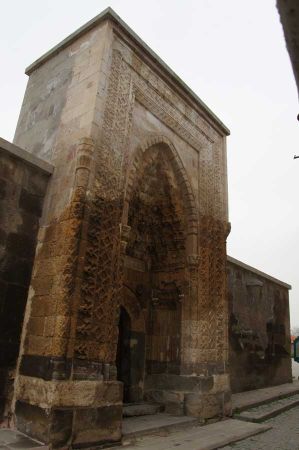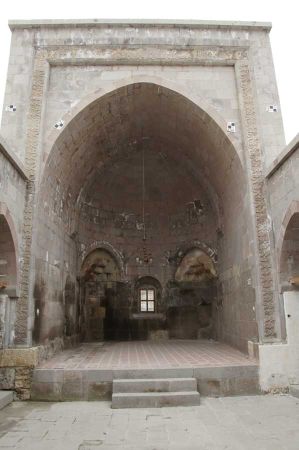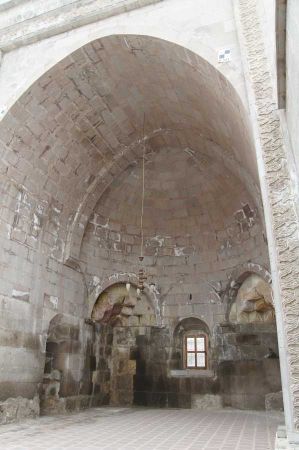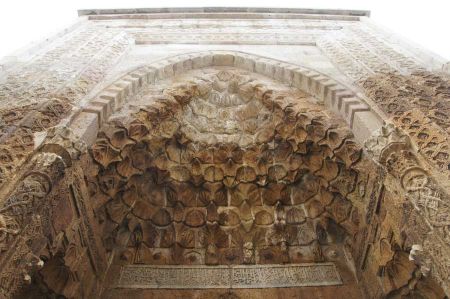Kremna, Eudikia, Caravanserai Kirkgöz Han & Evdir Han
- Written by Portal Editor
Once again we want to use the still wonderful warm sunny days in December to visit some more destinations from our seemingly endless list of places to visit or short travel destinations.
The destinations this time were the ancient Greek city of Kremna in Pisidia and the Seljuk Caravanserai Kirkgöz Han and Evdir Han as well as the Byzantine city of Eudikia.
We left Antalya on the national road 650 towards Isparta / Burdur past the Antalya bus station up to the plateau, which we crossed. Shortly before reaching the mountains there is a reference to the important turn to the left for us with the term "İnsubaşı". The original sign on the Kirkgöz Han was lost during the road construction work, at least we haven't seen it. About 900 meters after the descent, a narrow road leads to the left and after another 400 meters you reach the parking lot at Kirkgöz Han. We will add the satellite coordinates here as GPS, from the old town of Kaleici to here it is almost exactly 36 kilometres.
We found a building that was completely renovated and refurbished in 2008, now that it is probably privately owned and no longer accessible to visitors. A brief glimpse into the interior is just possible through a plexiglass pane at the entrance gate. The friendly guard on site explains freely that a private entrepreneur bought the Han and renovated it in order to use it for public celebrations. Perhaps this entrepreneur should also find a way to open it to visitors every day.
Caravanserai with elaborate entrance portals
 Kirkgöz Han, that is the rather well-preserved inscription above the gate, was built between 1237 and 1246 on behalf of Sultan Giyaseddin Keyhüsrev II. The gable alignment with the gate is exactly to the north, which is also shown in the 6-line, striking inscription. With its proud size of 33.00 to 52.00 meters, Kirkgöz Han is undoubtedly one of the great Seljuk caravanserai of the 12th century, the floor plan of which, like Evdir Han and other caravanserais, consists of rooms that are lined up as open, arcade-like vaulted cells are arranged around a large interior. In contrast to Evdir Han, a caravanserai built by cousin Sultan Izzeddin Keykavus I in the years 1215 - 1219, a large closed hall on the north side was set up in Kirkgöz Han. To the left and right of this hall there is a closed cell, which is repeated next to the entrance portal. It is likely that at least the cell to the right of the gate once served as a prayer room, similar to what we had already seen in Kargi Han.
Kirkgöz Han, that is the rather well-preserved inscription above the gate, was built between 1237 and 1246 on behalf of Sultan Giyaseddin Keyhüsrev II. The gable alignment with the gate is exactly to the north, which is also shown in the 6-line, striking inscription. With its proud size of 33.00 to 52.00 meters, Kirkgöz Han is undoubtedly one of the great Seljuk caravanserai of the 12th century, the floor plan of which, like Evdir Han and other caravanserais, consists of rooms that are lined up as open, arcade-like vaulted cells are arranged around a large interior. In contrast to Evdir Han, a caravanserai built by cousin Sultan Izzeddin Keykavus I in the years 1215 - 1219, a large closed hall on the north side was set up in Kirkgöz Han. To the left and right of this hall there is a closed cell, which is repeated next to the entrance portal. It is likely that at least the cell to the right of the gate once served as a prayer room, similar to what we had already seen in Kargi Han.
 We continue through the rugged mountain landscape of the former Pisidia towards Burdur / Isparta to the village of Girme / Çamlık in the province of Burdur, about 68 kilometres north of Antalya to the destination of ancient Kremna. Even the name Kremna (freely translated as "cliffs") says something about the location of the place, since it lies on a rock ridge that is about 1,200 meters high, which in turn rises about 250 meters from the high plateau, which was hardly conquerable, which is why the place was hardly mentioned historically. Just the Roman geographer Strabo reports of this place in his explanations, which was once conquered by the Galatian king Amyntas. After Amynta's death, the Romans took over the city and country. Under Emperor Augustus one tries to pacify the warlike mountain inhabitants of Pisidia, which now belonged to Galatia, by settling veterans in Kremna. The Romans did a similar tradition in the area.
We continue through the rugged mountain landscape of the former Pisidia towards Burdur / Isparta to the village of Girme / Çamlık in the province of Burdur, about 68 kilometres north of Antalya to the destination of ancient Kremna. Even the name Kremna (freely translated as "cliffs") says something about the location of the place, since it lies on a rock ridge that is about 1,200 meters high, which in turn rises about 250 meters from the high plateau, which was hardly conquerable, which is why the place was hardly mentioned historically. Just the Roman geographer Strabo reports of this place in his explanations, which was once conquered by the Galatian king Amyntas. After Amynta's death, the Romans took over the city and country. Under Emperor Augustus one tries to pacify the warlike mountain inhabitants of Pisidia, which now belonged to Galatia, by settling veterans in Kremna. The Romans did a similar tradition in the area.
It was in the 2nd and 3rd centuries AD that Kremna reached its heyday, which was reflected in many newly erected public buildings. A basilica was built, two theatres and a public bath house, which was later converted into a library and gallery. Amazing engineering performance can be found when looking at the city's water supply through aqueducts, some of which were operated mechanically.
Almost all of the ruins to be found come from the Middle Imperial and Late Antiquity, hardly visible signs from Greek times.
Bandit leader Lydios takes over Kremna
 Around 270 AD raids by bandits from the Taurus Mountains increased significantly. The historian Zosimos reports, among other things, about the bandit leader Lydios, who had attacked the coastal region near Antalya in 278 and had been driven from there by Roman troops. On his flight Lydios came to Kremna, which was then besieged and largely destroyed by the Romans. Kremna could not recover from this destruction and was abandoned by the residents in the following years. This is documented by British researchers, who have given numerous references to the siege by the Romans. They found two siege walls, many projectiles and a mound of the defending bandits and an inscription dedicated to the Emperor Probus.
Around 270 AD raids by bandits from the Taurus Mountains increased significantly. The historian Zosimos reports, among other things, about the bandit leader Lydios, who had attacked the coastal region near Antalya in 278 and had been driven from there by Roman troops. On his flight Lydios came to Kremna, which was then besieged and largely destroyed by the Romans. Kremna could not recover from this destruction and was abandoned by the residents in the following years. This is documented by British researchers, who have given numerous references to the siege by the Romans. They found two siege walls, many projectiles and a mound of the defending bandits and an inscription dedicated to the Emperor Probus.
Today Kremna / Cremna is still the titular diocese of the Roman Catholic Church of late antiquity.
We also decided to make a visit to the Evdir Han caravanserai on the way back to Antalya and used the junction from highway 650 to the E87 / 350 above Antalya to the right towards Korkuteli. Shortly after the junction (about 2 kilometres) you turn north (Evdir Han sign is present) and after another 1.5 kilometres you reach the ruins of the caravanserai. Evdir Han also belonged to the chain of caravanserais on the caravan route towards Konya and was built between 1210 and 1219. Similar in construction to Kirkgöz Han, you just need to check the formerly magnificent building at the entrance gate, because the gate is nicely decorated with ornaments.
The stop at Evdir Han is also gaining weight, as the ruins of the Byzantine city of Eudikia, which was founded by Emperor Theodosius II (from 408 - 450) and was intended for resettlers from Termessos, are in the immediate vicinity.
Enough ideas for you, dear readers, to continue exploring the region. There are a lot of interesting places worth visiting.
Please also read:
Wine cellar Petrov and its vaulted caps
Hungary - From the capture of the Magyars to today
